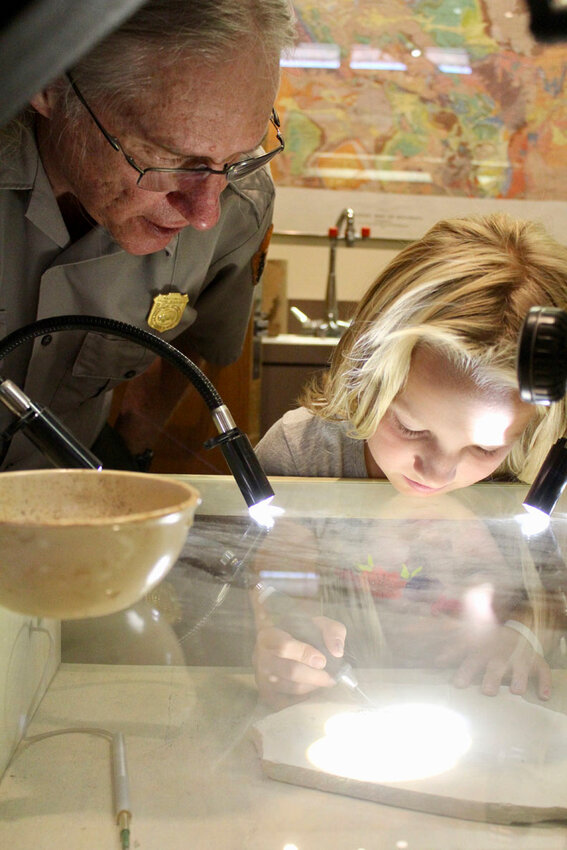The staff at Fossil Butte National Monument celebrated Earth Science Week and National Fossil Day on Saturday, Oct. 14.
This item is available in full to subscribers.
To continue reading, you will need to either log in to your subscriber account, or purchase a new subscription.
If you are a current print subscriber, you can set up a free website account and connect your subscription to it by clicking here.
If you are a digital subscriber with an active, online-only subscription then you already have an account here. Just reset your password if you've not yet logged in to your account on this new site.
Otherwise, click here to view your options for subscribing.
Please log in to continue |
Joesn Capell, age 5, prepares a small fossil using the scratch method at one of the activity stations during the Fossil Day celebrations at Fossil Butte on Saturday, Oct. 14. (GAZETTE PHOTO / Michelle Tibbetts)
The staff at Fossil Butte National Monument celebrated Earth Science Week and National Fossil Day on Saturday, Oct. 14.
Fossil Butte welcomed locals and tourists to try their hand at fossil preparation and learn about the ancient Fossil Lake and its evolution.
Visitors could choose from a variety of activities, including rubbing plates, touch tables and an ecosystem cut and paste craft.
Fossil Butte park education technician John Collins was on site sharing his wealth of knowledge with visitors who had the chance to get involved with many aspects of fossil preparation.

Bridger Valley resident Nevaeh Major gets some instruction on fossil preparation from John Collins, Park Education Technician, at Fossil Butte's Fossil Day celebrations. (GAZETTE PHOTO / Michelle Tibbetts)
Collins explained how fossil preparation techniques have advanced over the years.
Attendees could then actually use the modern equipment in the fossil preparation booth. Collins demonstrated two different preparation tools – the air scribe and the micro-air abrasive.
“It’s like a mini sand blaster,” Collins said of the air scribe. “Powered by an air compressor, the tool blows a very fine iron powder.”
The iron powder breaks away the limestone layer, exposing the fossilized remains. After Collins’ brief explanation, people were invited to give the equipment a try and learn firsthand what it is like to be a fossil preparatory.
Each operator used a microscope to examine the fossil as they removed the layers of limestone to reveal delicate bones of fossilized fish.
People could view the work being done in great detail, thanks to the video monitor broadcasting the action to the crowd in the monument museum.

Julie Gonzalez, a park ranger from Glacier National Park, gets her turn at the air scribe machine as she works to reveal the fine rib bones of an ancient fossil fish. The crowd enjoyed the close-up view of her work as it was displayed on the video screen. (GAZETTE PHOTO / Michelle Tibbetts)
“It was fun,” said Elizabeth Wetz of Kemmerer. “It was my first time working on a fossil.” Wetz had a chance to use the micro-abrasive tool.
At the scratch station, many kids loved using the small hand tools to scratch away at outer layers of rock to reveal the fossils below.
“What is that smell?” someone said as they scratched the fossils.
Collins explained that many small micro-organisms died and fell to the bottom on the ancient lake to form layers.
Over time the layers became very compressed and transformed into kerogen. The decayed materials and the waxy solids of hydrocarbon were exposed to high temperatures and pressure, which eventually became oil or natural gas, referred to as “oil shales.”
As the attendees scraped at the limestone rock, the friction freed the vapors and produced a kerosene-like smell.

Wesley O’Brien plays at the stamping station where visitors could endorse their National Park passport books during the Fossil Day celebrations on Saturday, Oct.14. (GAZETTE PHOTO / Michelle Tibbetts)
Fossil Butte supervisory park ranger Amanda Wilson thanked everyone who attended the celebration and discussed Fossil Butte’s year-round activities.
Wilson also mentioned that those who cannot make the journey to the monument should ask their local school administrators to allow them to participate in Fossil Butte’s virtual field trips.
These live video meetings connect students and rangers for an educational experience right in the classroom.
“We try to tailor the tour to what the class wants to focus on,” Wilson said. “We showcase the museum's specimens and the difference between the past and present ecosystems.”
There is no fee for this virtual field trip. Wilson said she has provided virtual Fossil Butte field trips to schools in places as far away as Australia and India, and also many schools in Wyoming.